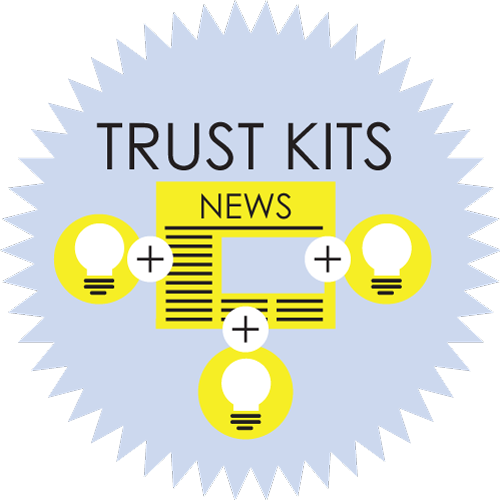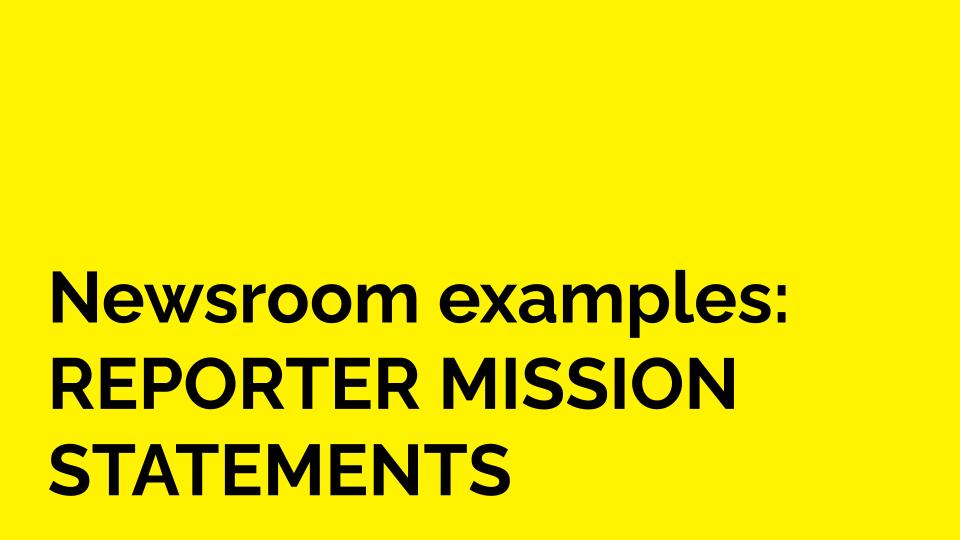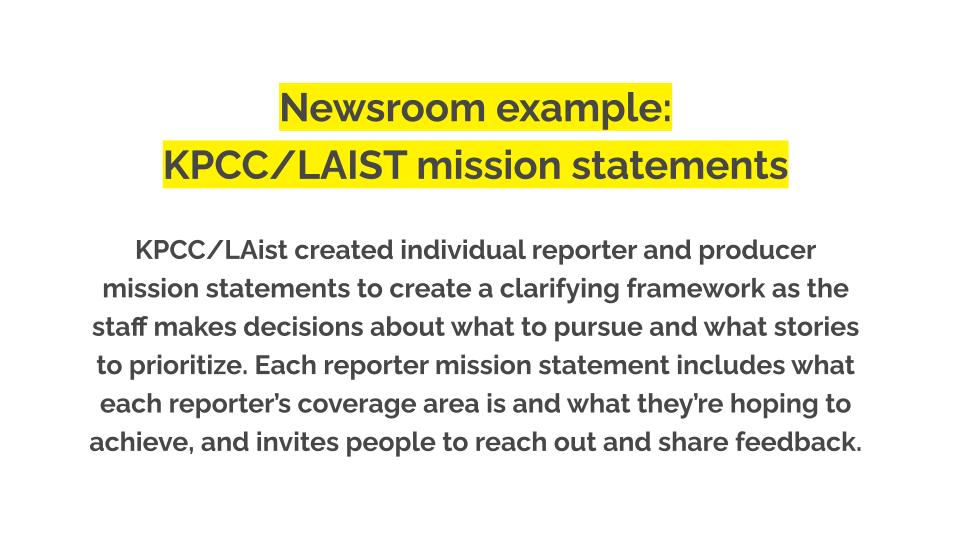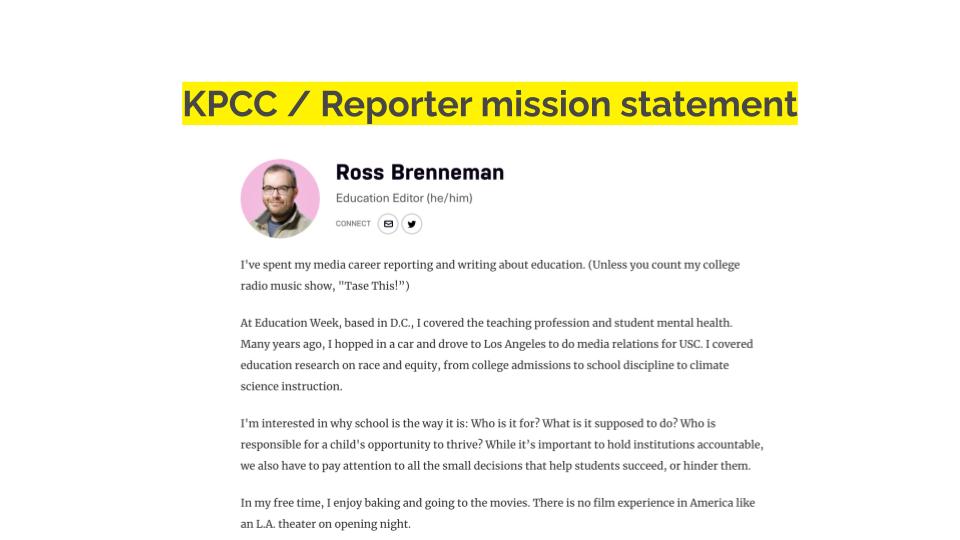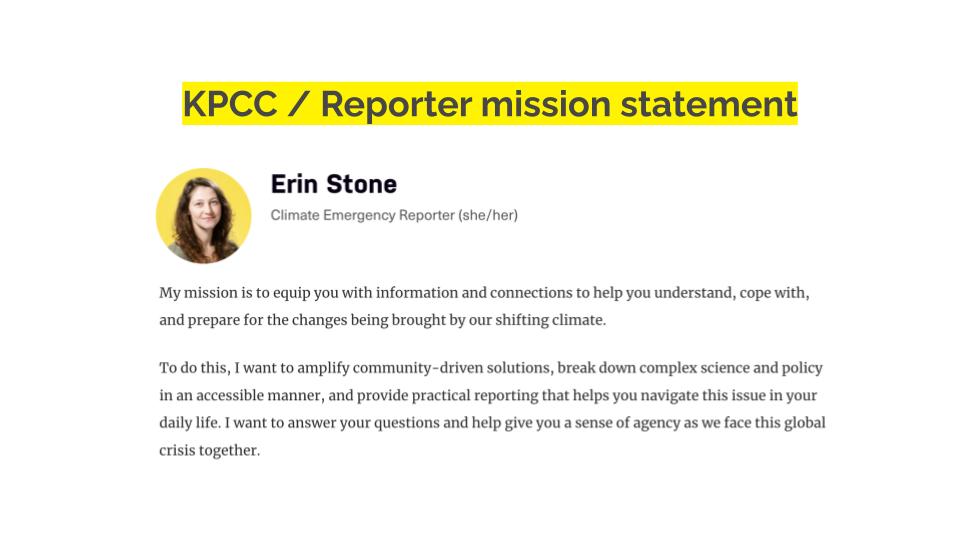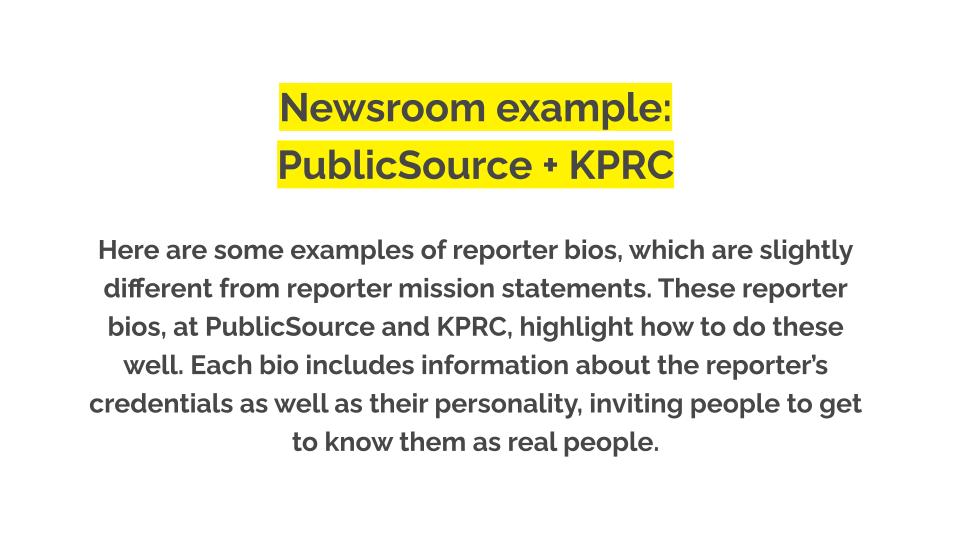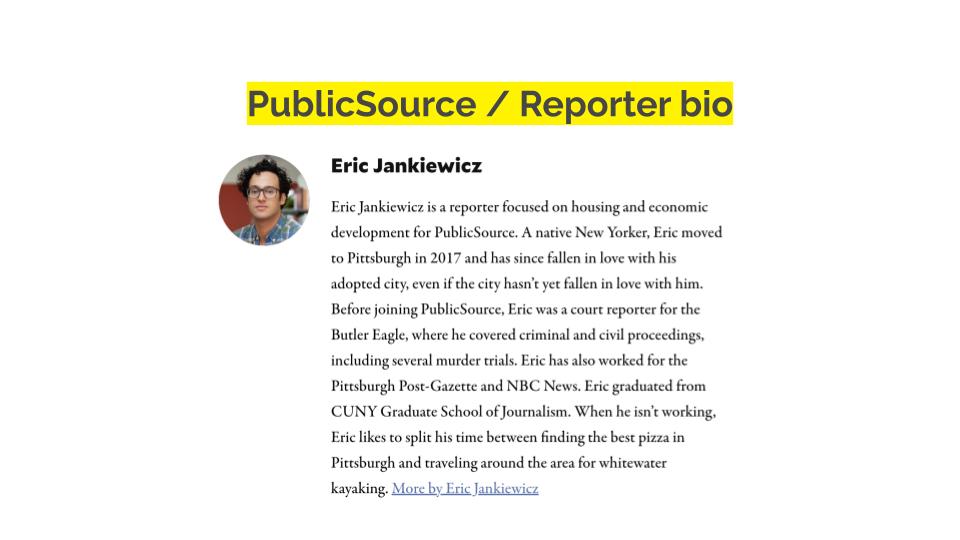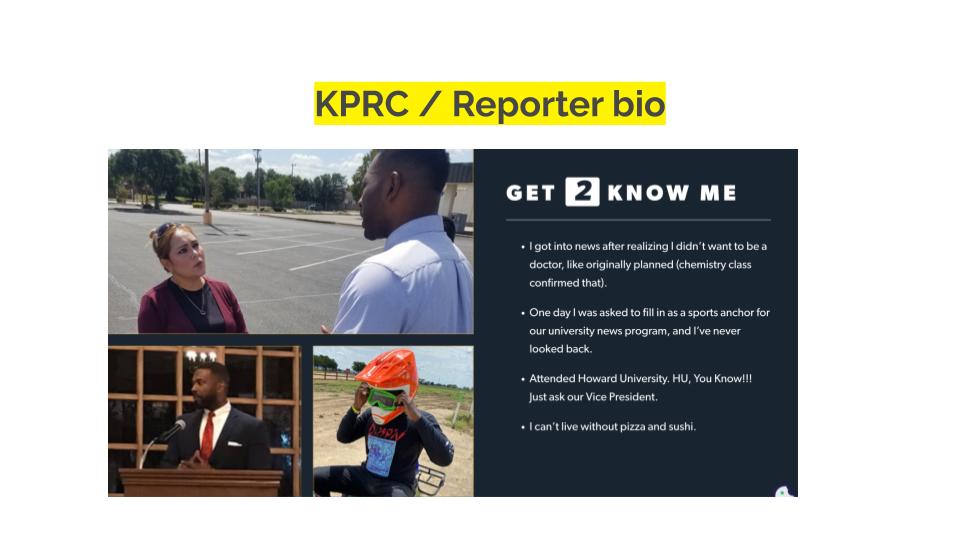ETHICS & FAIRNESS
Reporter mission statements
Rather than letting your audience make assumptions about your agenda, tell them what you’re trying to accomplish.
We know people are curious about why you choose to cover certain stories and often make negative assumptions about why (or why not) a story was covered, how much attention it received (story length, story placement, etc.) and what elements were included (or not included) in the coverage.
Newsrooms often address this curiosity by having a mission statement or value statement for the news organization. This is a good start but often the statements are written in journalism jargon and not helpful for a user to understand what you cover, when they should contact you or what your reporting goals are.
To help a user better understand how you approach stories and decide what to cover, we recommend publishing reporter mission statements and staff bios.
Trust is often based on how well we know and understand someone. It’s true in personal relationships, and it’s also true for journalists.

Mission statements versus bios
You probably already have staff bios for each journalist on your team. That’s good, because being able to identify who a reporter is, their expertise and experience can lead to credibility which helps build trust. A reporter mission statement is a bit different though.
Reporter mission statements show users what an individual journalist’s goals are and what they are trying to accomplish. The statement also helps show how a reporter’s mission aligns with the community’s mission. (More on why that is important here.)
Most importantly, a reporter mission statement is written with the audience in mind.
What’s the difference?
REPORTER & STAFF BIOS
- About the journalist
- Focus on journalist’s expertise
- Discuss awards, experience, past work of journalist
- Will change but not frequently
- Written in a couple of paragraphs
- Can include personal details about the journalist’s life
- Include photo
- Include contact information (including perhaps what specifically the public can contact you about)
MISSION STATEMENTS
- About the journalist
- Focus on journalist’s expertise
- Discuss what the journalist hopes to achieve with reporting
- Will change with coverage goals
- Written in two or three sentences
- Include details about reporting beat and coverage goals
- Include photo
- Include contact information (including perhaps what specifically the public can contact you about)
Here’s a great example of a staff bio from PublicSource reporter Lajja Mistry. It shares her credentials, experience and also shares some of her hobbies.
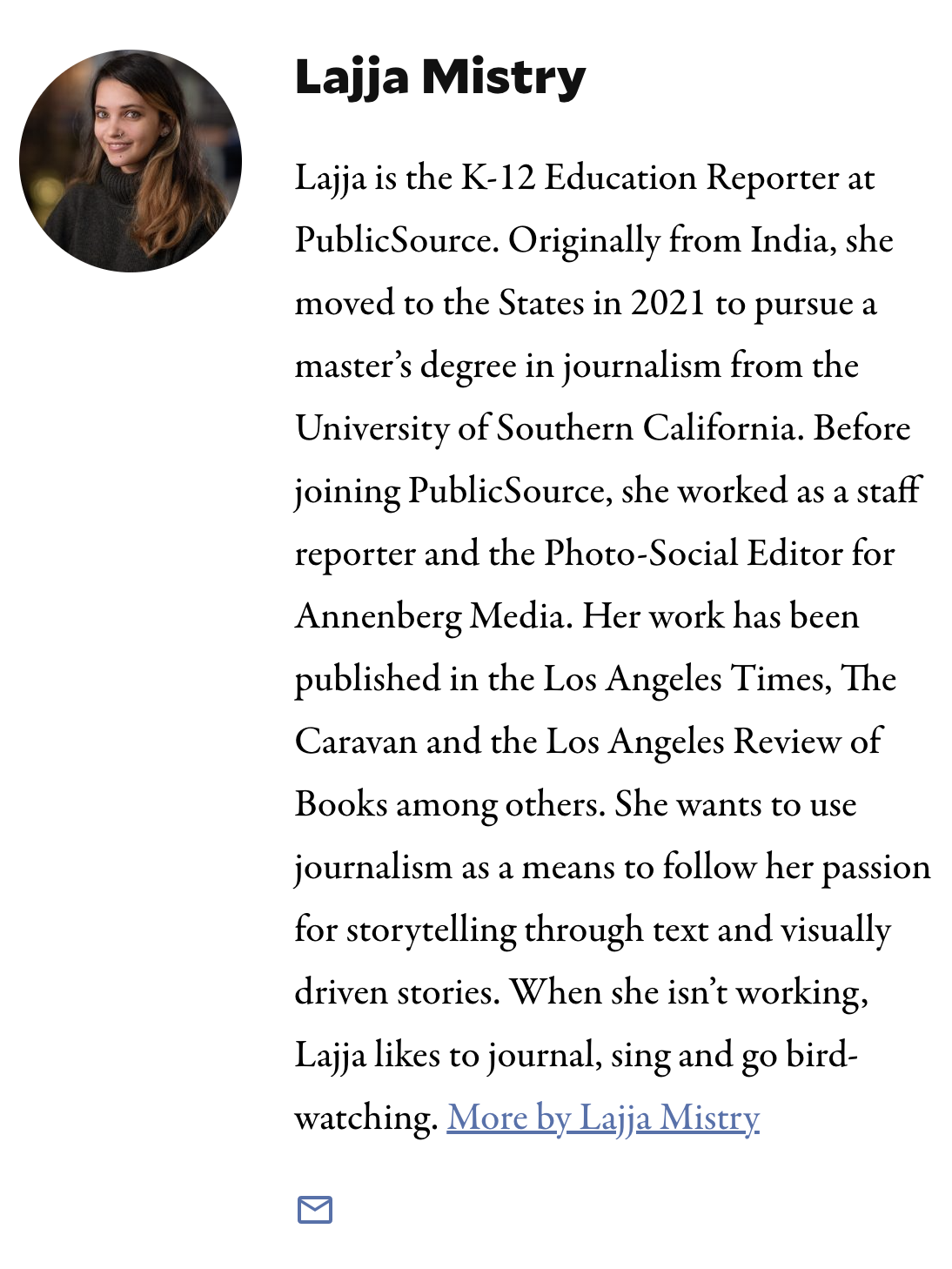
Here’s former KPCC reporter Alyssa Perry’s mission statement. It includes what she covers, what she’s hoping to achieve, and invites people to reach out.
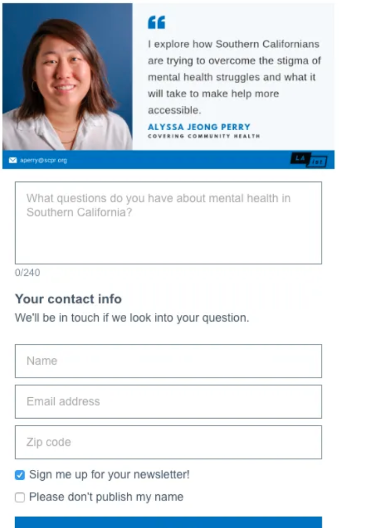

Your turn!
If you’re ready to get started, expand the below sections by clicking the plus (+) sign to learn how to write a reporter mission statement and share it out publicly. Click or tap the blue boxes to expand each section.
How to create a reporter mission statement
Creating a reporter mission statement begins with answering questions about your reporting. If you want people to have a better understanding of what each journalist covers and why, the journalist should first spend time reflecting on questions about their goals and mission.
To get started answer the questions below.
- What types of stories do you cover?
- What is the goal of your coverage?
- What are you hoping to achieve with your stories?
- What types of issues should people contact you about?
- Why do you focus on these types of stories?
When answering these questions, think of real people — neighbors, children’s teachers, dedicated users and casual users. What do you offer them? The story you need to tell is about your users not about you (that’s what the staff bio is for). The reporter mission statement should focus on what users will get from you and your reporting while learning a bit about what you are trying to accomplish and what potential stories or issues they should contact you about.
After you answer these questions, use the answers to create the reporter mission statement. Condense your answers into two to three sentences. Once that is complete, share the statements with a couple of others in the newsroom (maybe even some community members) and make edits accordingly. This feedback can help the statements be written in more user-focused language to be useful for users (which is the goal!)
It’s great if the mission statement includes a call to action too. You could include information about how users can get in touch with you and why. Is it for story ideas? If so, what kind? What focus are you interested in? Should users contact you for possible leads on sources? Or should users contact you with questions related to your reporting focus? Be specific in your ask. For example, “follow my work to learn more about food accessibility and to tell me more about how the issue affects your life or community.”
How to use reporter mission statements
These mission statements can be added to staff bio pages but should also be added to daily content. Adding the mission statement to the story (bottom, middle, side, etc.) helps users understand your reporting goals while also making it easier to contact you and why they might contact you.
Some newsrooms turn the mission statement into a photo card and share it on social media or embed them at the end of stories. Another idea is to include a hyperlink on the author’s name in their byline that links to a bio page that includes their staff bio AND their reporter mission statement.
As you use these statements, remember to update them as the goals of coverage or types of stories you are covering change. You could also ask the community what they want to see related to these topics and consider focusing the beats on that community feedback.
In addition to creating reporter mission statements, you can use the same approach to create a mission statement for a particular beat (investigation teams) or event (the election).
See how other newsrooms do it
For some inspiration, click or swipe through the below examples of reporter mission statements and staff bios. For more newsroom examples, check our our newsroom example database.

We’re here to help!
Congratulations on getting this far in the Trust Kit! 🎉 We know taking the steps to earn trust isn’t always simple or easy. It takes time and often requires a shift in newsroom routines or workflows.
Any progress you make on implementing strategies in this Trust Kit should be celebrated as a win!
